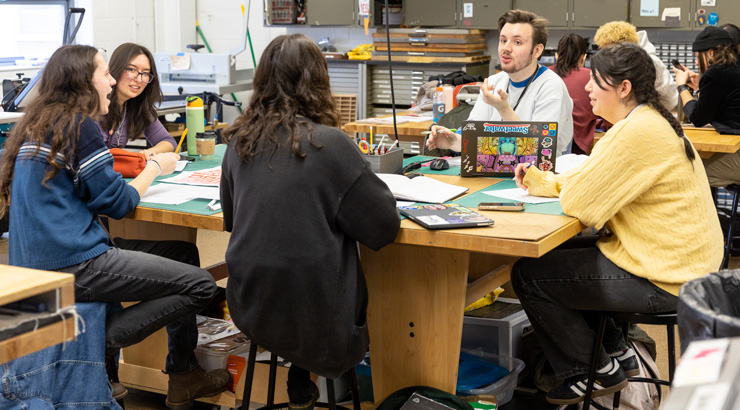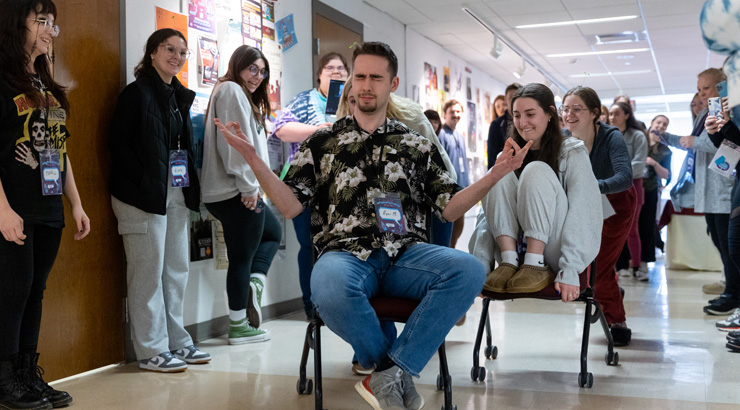
Eat. Collab. Design. Repeat. Designathon gives students real-world experience working with local nonprofits
By Ash Nave '17

It’s 9 a.m. on a Friday. Sketch pads are out. Pencils are scribbling. And students are gearing up for an intense 12 hours of creative collaboration in Kutztown University’s Sharadin Arts Building.
Known as the biggest design extravaganza on campus, Designathon is an annual graphic design event that gives students the opportunity to produce outstanding pro bono work for local nonprofit organizations.
While it’s no easy feat designing and delivering press-ready artwork in less than a day, Designathon is a volunteer-based event, where students come together and create designs based on a client’s project request.
“There’s a sort of magic that happens where the students are under pressure in a shorter time frame and just produce amazing work,” says Vicki Meloney ’93, communication design professor and longstanding Designathon cohost.

‘This is like our prom’
Meloney says that the true moment of excitement begins right before the event starts, when students find out what they’re designing, who they’re designing for and which teams they’re on….
Students love the intensity of the event, she says, and have even said, “This is like our prom!”
Summer Doll-Myers, associate professor of communication design who also cohosts the event, serves as the liaison between student teams and team leaders, which are usually professors or alumni who volunteer to chaperone the students.
“There are about four students per team, depending on the scope of the project,” Doll-Myers says. “Sometimes there are multiple parts to a client’s request, so that’s when I have to look at what each student’s strengths are and what professor would be best overseeing what group.”
Clients are also required to fill out a Google form prior to the event, allowing Meloney to review the scope of the project and determine if it’s doable within the given timeframe.
Not only does the event give back to the community, but this is a resume[1]builder for the students who participate.
“The benefits of Designation are innumerable. The connections, the real[1]world experience, the friends you make along the way, these are all things I’ve taken away from this amazing program,” says two-time Designathon participant and recent KU Communication Design graduate Robby Derr ’24. “Getting to work in the industry for a day is so affirming that this is my dream career, and I recommend all communication design students take part in Designathon at least once.”
Approaching the $2 million mark
The event first came to campus in 2005, thanks to Meloney and communication design professor Todd McFeely.
“There were only a handful of students who did it that first year and there were only a couple of clients. We did it for 24 hours, and after that year, clients asked when we were doing the event again,” Meloney says.
Even though they’ve moved away from the original 24-hour timeframe, Designathon has grown exponentially over the years.
he 10-year anniversary of Designathon was their biggest turnout, bringing together about 130 student volunteers and 40 clients from the local community. This year, Designathon – which is typically held in the spring semester – had a turnout of 94 students, 21 clients, 11 alumni and 10 faculty and staff volunteers.
“We’ve done some really fun things for clients over the years. We’ve done a parade float design, and recently, someone asked us for a mascot – a unicorn playing bagpipes,” Doll-Myers says.
The amount of time and effort that KU has donated in pro bono designs is even more impressive.
“If you put an hourly rate on the students’ designs and what they would charge at an agency, the amount of money we’ve donated with our time is well over a million dollars,” Meloney says. “It might even be approaching the $2-million mark at this point.”

The ultimate tripod
“One of the reasons this event is successful is that we work really well together,” Meloney says. Alongside Meloney and Doll-Myers is the third leg to the Designathon tripod, Kathy Traylor, the Art and Design Department secretary who is responsible for reserving the rooms for the event and coordinating meals throughout the day.
“We start the morning off serving students a hearty breakfast because we want to make sure they’re well-fed, so their energy levels stay at a high for the next 12 to 16 hours,” Traylor says.
“We learned over the years that we need have to high-energy foods – good, healthy foods – because Designathon is an endurance game,” Meloney says.
“I also like to have a couple of games going for the students, like this year’s chair race down the hallways, just to get them out of their seats and more involved with the entire group,” Traylor says.
While Traylor coordinates logistics and Doll-Myers organizes student teams and designs promotional artwork for the event, Meloney takes charge of the initial email to clients. The email reaches about 200 nonprofit groups several months before the event, inviting them to complete their Google form applications. Once they’re approved to participate, the organizations are invited to attend the opening and closing ceremonies of the event on Zoom.
The opening ceremony usually begins about 9 a.m., when students meet the clients for the first time and find out what their projects are.
About 9 p.m. later that day, students go back into breakout rooms on Zoom to present their final work to the client.
Christi Terefenko, executive director of VOiCEup Berks, a volunteer organization dedicated to providing meaningful volunteer and service opportunities throughout the Berks County community, says that this is the organization’s first year participating in Designathon.
“The team I worked with for Designathon went beyond merely creating a logo for a budding youth program. Their vision exceeded my initial proposal and inspired me to think bigger,” she says. “We will use these designs to launch a new initiative aimed at college[1]age adults, helping them to connect with their community and with each other.”
This article originally appeared in the 2024 Tower Magazine.





